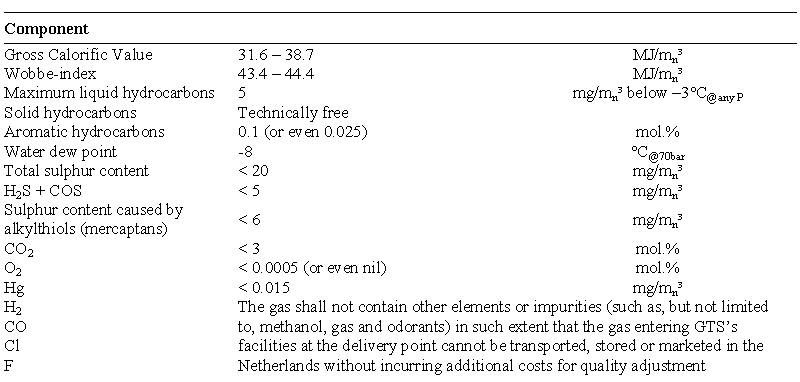SNG specifications for grid injection
The supplied gas has to meet strict specifications, regarding composition, Wobbe-index, calorific value, and relative density. In order to produce the desired qualities of natural gas, gas streams from different sources are mixed at the various blending stations of the Dutch natural gas infrastructure. Not all natural gas is the same as Groningen gas (G gas). In the North Sea large amounts of high-calorific gas are released during the extraction of mineral oil, as associated gas, with high concentration of high hydrocarbons. Also many of the small fields contain gas of high calorific value (H-gas), while others contain gas of low calorific value (L gas), rich in carbon dioxide [1].
Since the gas appliances of nearly all Dutch consumers at the time when the small fields came on stream were designed for G-gas, there was not a ready market for H-gas and L-gas as such. To serve large industrial users, whose installations could be converted to H-gas, an extra system of main transmission pipelines was built. H gas and L gas were mixed to produce a gas of Groningen quality, which could be introduced into the main transmission system for G gas. Furthermore H-gas was diluted with nitrogen to achieve Groningen quality before introduction into the G gas pipelines. As SNG will (mainly) be introduced as a renewable natural gas for domestic consumers it’s specifications should match with those of G gas.
Based on the effects of various components, combustion and transportation behaviour, as well as health issues criteria for SNG can be specified in such a way that the renewable or “green” gas can be transported, stored or marketed in the Netherlands without incurring additional costs for quality adjustment, hence is of a quality that will not cause damage to either transmission system or consumer applications. It is also taken into account components that according to ECN might be present in the SNG and formulated the specifications as presented in the table below. In order to be transported through the existing gas grid and utilised in existing natural gas fired apparatuses the SNG should (at least after blending) have a Wobbe-index that is conform the Wobbe-index of natural gas.

These specifications, with regards to some specific components, are still vague. Gasunie, however, is planning a European research work that will focus on detailed specifications of biogas within both the Dutch and the European natural gas grid. SNG, as a biogas, will form a part of this specific study. This European study will also reveal differences in specifications, depending on where SNG will be injected in the grid. With regards to the specifications presented in the table the specification for, e.g., CO2 in G-gas depends on the area where the gas is distributed: in the western part of the Netherlands it might even be 8 mol%. As the distributed gas might end up in both parts the gas should (at least after blending) be able to comply with both specifications.
References:
M. Elderman, H. Y. Becht and B. J. C. M. Rutten: Gefaseerde inzet van waterstof in de energie-infrastructuur van aardgas. Centrum voor energiebesparing en schone technologie, 1990, The Netherlands.